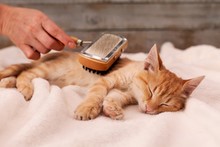
Cats are naturally clean creatures, constantly licking and tending to their fur. Even though they are great at this, sometimes we, as pet parents, need to intervene and help with their grooming needs. Here’s how you can help keep your feline friend in great shape.
Maintaining a Shiny Coat

A cat’s healthy skin and coat begins with good nutrition (speak to your veterinarian), but good grooming helps too. Simply brushing your cat’s fur can help prevent mats, tangles and hairballs as well as remove dirt, grease and dead fur from their coat. Brushing also helps remove skin flakes, stimulate blood circulation and distribute healthy oils from their skin throughout their fur, promoting healthy hair growth. Plus, brushing can be a great way to bond with your kitty. Luckily most cats enjoy being brushed. And the close attention you give while grooming can lead to early detection of symptoms of a developing health problem like lumps, bumps or sores. If you cat is new to brushing, let them check out the brush on their own terms and keep sessions short in the beginning to ease them into this new experience. And be sure to provide treats and praise during and after every brushing session to help promote positive association.
Good Dental Hygiene
Many pet parents ignore dental hygiene until their pet has offensively bad breath or shows difficulty eating. But by this point, the issue can be quite advanced and most likely proper dental care could have prevented the problem in the first place. Similar to humans, cats develop plaque and bacteria on their teeth, gums and tongue leading to gingivitis, periodontitis, and mouth ulcers. Fortunately, a program of preventive dental care can keep your cat’s mouth clean and healthy.

First, we recommend that you ask your vet to demonstrate a basic oral exam that you can repeat at home to look for signs of trouble like inflamed or bleeding gums, loose, broken or discolored teeth and bad breath. Then, you can work on making tooth brushing a part of their regular routine. Doing this task daily would be most ideal, but let’s be real – no one has time for that and most cats won’t put up with it that often. So, start with once a month and see if you can increase to once a week.
Like all new experiences, you’ll have to introduce tooth brushing in stages and keep it a happy experience for your cat. Make sure to get toothpaste specially formulated for cats. Start by briefly running a finger with a little toothpaste on it gently across their teeth and gums while petting and praising your kitty. Slowly increase the amount of time you spend doing this until you can rub the outer surfaces of all of their teeth. Then you can introduce the brush. You may need to cut back the time spent once you introduce the brush and slowly increase again once they get used to the feel of the bristles.
Paws & Claws
Cats use their claws for scratching, climbing and marking territory. Their nails are continuously growing and the activity of most indoor cats is not enough to keep them trim. You should work on trimming your cat’s nails every 2 weeks. If not, their nails will continue to grow, potentially harming humans or furniture and eventually curling into the footpad causing severe pain and difficulty walking. Overgrown nails also become curved and don’t retract completely, getting stuck in carpet and other soft surfaces. Contrary to popular belief, scratchers and scratching posts do not keep claws trimmed, they only provide a safe surface for cats to scratch. Human intervention is needed to keep the nails short.

However, most cats do not enjoy getting their nails trimmed so it is really important to desensitize your cat to having their feet, pads and toes handled before attempting to cut their nails. Even if you decide to use a groomer for this service, getting your cat familiar with having their feet touched will be extremely helpful. Here’s how you’ll do it:
- Select a comfortable, quiet space away from distractions and windows and hold your cat in your lap at a time when they are calm and sleepy, like after a meal.
- Before attempting to trim their nails, spend several days, even weeks, massaging your cat’s legs and paws, pressing gently on each foot pad to extend the corresponding nail. Release immediately and give your cat treats and praise to normalize this type of touch.
- Then you need to acclimate kitty to the nail clipper and the sound it makes. You can do this by repeating the above with an extra step: “trimming” an uncooked piece of spaghetti each time your cat’s nail extends. Release the pressure and immediately reward your cat.
- Once your cat is calm and comfortable with you touching their paws, you are ready to trim their nails. Make sure to only cut the sharp tip of each nail and NOT THE QUICK (pink part of the nail containing blood vessels).
You may not be able to trim all of their nails in one sitting, or even all of their nails on one foot – especially on the first go. Be patient and continually provide positive reinforcement and your cat will trust and enjoy the process more and more. However, if your cat refuses to allow you to trim their nails, take them to a professional.

Following the above steps to get your cat comfortable with you touching their feet can also help you monitor the health of your feline companion’s paws for any wounds, small cuts and sores that can develop. Wiping paws on a daily basis with a warm wet towel can help remove everyday dirt and debris as well as chemicals they pick up from the cleaning supplies on floors and other surfaces. Some longhair cats can become irritated by hair in between their toes. If you notice your cat biting their feet, it may be a sign that they need a trim around their toes.
Check Your Cat’s Ears

Ears are often an overlooked part of cat care, but keeping them clean should be a part of your cat’s grooming routine. Weekly ear checks and cleanings, can prevent common problems like ear mites, allergies and infections. To notice any issues, you need to know what your cat’s ears usually look like. To view inside their ear, hold the tip between your thumb and forefinger and gently roll it outward revealing the inner ear. Inside should be pale pink and odorless with a small amount of light brown wax.
If the ear appears healthy, gently wipe the inside with a pad soaked with ear wash to help break down dirt and wax build up. Never insert a Q-Tip or anything else into the ear canal. This could cause serious damage.
If the ear appears red and sore or there is a lot of discharge-especially red, black or greenish yellow – you should take your cat to the vet. If you cat is scratching their ears or shaking their head a lot, this also warrants a trip to the doctor because ear problems can be hard to diagnose without microscopic examination to determine the cause and best form of treatment.
Keeping up with your kitty’s grooming needs is a must. Adding these things to your regular routine will not only help strengthen the bond you have with your cat, but will also help keep your cat as healthy as possible while making it easier for you to notice if something is wrong.





Leave a Reply